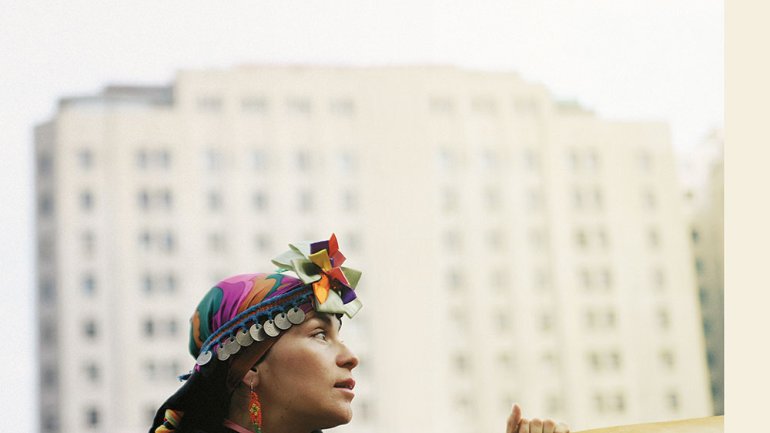Chile: Deeply Rooted Craft
Chile: Deeply Rooted Craft
Nestled between the Andes and the Pacific Ocean, some 400 miles south of Santiago, Chile, the fiercely independent Mapuche people have endured for more than 10,000 years, fending off both the Incas and Spanish conquistadors. Despite conflicts that still flare between the Mapuche and Chile’s national government over land rights, their culture has had a decisive influence on modern-day Chile. Mapuche language, food, and customs are woven into Chilean tradition – particularly their remarkable handwork.
Mapuche women pass on their unique textile skills to their families, guarding their secrets closely to protect their traditions and livelihood. Made from sheep’s wool that is washed, stretched, spun, and dyed, Mapuche blankets and rugs are easily identifiable by their colors and patterns, with abstracted geometric motifs that symbolize plants, animals, elements such as fire or rain, and spiritual life. Mothers teach their children to weave, explaining the origins of these symbols and the beliefs of their ancestors.
It’s a very hands-on process. Mapuche women build their own looms with native wood, spin their yarn by hand, and create natural dyes using plant and animal sources.
Margarita Ñanculef is one of these artisans, taught to weave by her mother at a young age. By 13, Ñanculef was creating her own pieces, which her father sold in Temuco, the capital of southern Chile’s Araucanía region. As a young adult, she helped support the family with her skills. Now, with her own family, Ñanculef was able to send her children to technical school with income earned by selling her craft pieces through the Fundación Chol-Chol, a nonprofit fair-trade organization based in Temuco. As she says in a testimonial on the Chol-Chol website: “I don’t depend on anyone. I, by my own hands, earn. My works have gone to different places outside of the country, from the United States to Peru.
“I am proud to be Mapuche,” Ñanculef adds, “because if we didn’t work, we would let the Mapuche culture die; then we would be a lost people.”
Ñanculef is also a master artisan with VOZ, a fair-trade fashion collective based in San Francisco. VOZ partners with Mapuche weavers to design and produce their distinctive line of woven apparel and accessories.
Some 200 miles north of Temuco is Rari, a rural village of old colonial houses and home to Maestra Madre de Rari, an artisan group of 16 women who are experts in the unique craft of weaving with crin – hair from a horse’s mane and tail. The group organized in 1998, led by Sara Toro and Nancy Alcanta, to create the first micro-enterprise of Rari artisans.
The art of weaving with crin is traditionally passed down from mother to daughter, and some have been practicing it for more than 70 years. Toro learned from her mother at age 7; for her, the best aspect of the craft is its uniqueness. “There is no mold for this,” she says. “No two pieces are alike.”
Weaving with dyed horsehair dates back at least two centuries and is unique to this region. Every aspect is done by hand: The mane is hand-washed, bleached, and then dyed before being woven into vibrant designs ranging from tourist souvenirs such as flowers, dolls, and small baskets, to high-end home and fashion goods sold in Santiago’s boutiques.
The Maestra Madre de Rari workshop also offers demonstrations and lessons to visitors, who quickly realize the folk art takes a lifetime to master. Another local cooperative is El Arte del Crin, started by Alba Rosa Sepúlveda Tapia, who more than 50 years ago began hand-weaving delicate miniature sculptures and designs.
Born into a family of artisans from Rari, today Tapia is one of the foremost weavers in Chile and has received widespread international recognition, including the UNESCO Award of Excellence for Handicrafts. Her fair-trade cooperative helps artisans support themselves and pass along the tradition to the next generation. Tapia also shows her work in the United States at the annual Santa Fe International Folk Art Market.
Fashion designers have recently discovered Rari horsehair products and started incorporating them into their lines, says Emerson Basoalto Toro of Maule Tourism. “The challenge for Rari artisans today is to continue innovating and developing products for the modern woman,” he notes.
Urban craft shops and cooperatives in Santiago are helping bring these ancient techniques into the world of modern art and fashion. Fundación Artesanías de Chile operates three stores in the city, selling handcrafted pieces including Mapuche textiles, willow basketry, pottery, and copper work from more than 1,800 craftspeople throughout Chile, under a fair-trade agreement. Almost 60 percent of FAC’s network is made up of indigenous people, who find a market for their work, along with employment and training opportunities.
FAC also opened an exhibition at Santiago International Airport in August, in partnership with Mexico, showcasing the traditional crafts and techniques of both countries. Other excellent spots in Santiago for high-end craft include the shops in the bohemian Bellavista neighborhood, Galería del Mundo in the town hall on Plaza de Armas, and Walka Studio, which also has been recognized by UNESCO for combining traditional Chilean crafts with contemporary jewelry.
For a full range of South American crafts, the International Showcase of Traditional Crafts held in Santiago each November is a must-see. More than 150 artisans from various Latin American countries gather at Vitacura Bicentennial Park to display their work, alongside booths selling regional food specialties and musicians playing lively Chilean folk music.
The festival has become an important event for both artisans and collectors to meet and has been instrumental in bringing awareness of traditional crafts to modern Chile. The festival helps preserve cultural heritage while bringing the handmade to a global audience.
Shelley Seale is a freelance journalist and author based in Austin, Texas. Her stories have appeared in National Geographic and USA Today.

